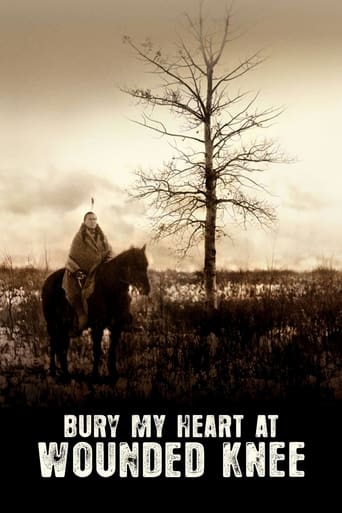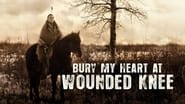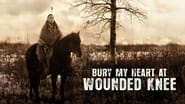Ric-7
I recently found this movie in searching for Dee Brown's book at the local public library. I recall reading the book when it first came out, decades ago, and I was fascinated--a history book that I could not put down, just like The Exorcist (the book) when I first read it. Dee Brown's book was also a horror story, and the major horror was that it was real.So knowing absolutely nothing about the movie, I borrowed it, thinking that it would be essentially a documentary. Was I wrong! I should have just checked out the book and read it again. Historic atrocities can only be properly dramatized by extraordinarily gifted filmmakers. Anything else is a reduction. But perhaps it is better if someone stumbles upon the Native American genocide done up as a popcorn movie, than never to have any idea at all.The NY Times review complained of some rather obvious analogies to Iraq and Afghanistan. That further illustrates the reduction--would anyone dare use the Holocaust as an analogy for anything else? I don't fault the production, which was polished and accomplished. But HBO should have passed on this.
irish23
The movie is compelling and (of course) full of pathos. It presents complexities not normally addressed in "good guy vs bad guy" films. But it also presents a number of highly complex situations that it can't possibly resolve in a movie format. A documentary would be better suited.The acting was excellent, with the exception of the ever-predictable Aidan Quinn. Anna Paquin was impressively in command of her performance and did much better than I expected. The rest of the cast was just as good.This picture made me cry like a documentary would but didn't draw me in like a compelling movie. I think it's just a case of wrong medium for the story.
sol
The trail of tears that lead to the massacre at Wounded Knee on December 29, 1890 started in the Summer of 1876 at the Little Big Horn. It was there where Gen. George Armstrong Custer and over 250 men under his command was slaughtered to the last man, the only survivor of Custer's troop being a calvary horse called Comanche, by the fired up Sioux Indians.Wanting revenge for what turned out to be the worst defeat that the US Calvary suffered in the Indian Wars the "Great White Father" President Ulysses S. Grant, Fred Thompson, sent a much bigger military detachment headed by, as he's called by the Sioux, Gen.Bear-Coat to put a final end to the Dakota Indian uprising. Confronting Chief Sitting Bull, August Schellenberg, and his some three thousand warriors at Ceder Valley Creek Gen. Bear-Coat had no trouble dispersing the Sioux onslaught mowing down hundreds of Sitting Bull's men with volleys of rifle and cannon fire.Dispersed and on the brink of starvation Sitting Bull's rival Chief Red Cloud, Gordon Tootoosis, was forced to sign away his peoples rights to where they became wards of the state living off the kindness and charity of the hated White Man. Sitting Bull wanting none of this took his followers to Canada where after suffering through a number of harsh Canadian Winters, far worse then any of the winters in the Dakota Territories, later came back hat in hand accepting the unthinkable: living under the White Man's both rule and law. It was the deception and manipulation by the US Government in trying to force Sitting Bull and his people to sign away their ancestral lands that eventually lead to the wild and hysterical events that lead to Wounded Knee. The story of "Bury My Heart at Wounded Knee" is told to us through the personal observations of Charles Eastman, Adam Beach, formerly known by his Sioux Indian name of Ohiyesa. Eastman was an 18 year old at the battle of Little Big Horn where he earned his warrior's feather in killing a horse soldier of Gen. Custer's 7th Calvary in the fighting. Now grown up and earning a medical degree Eastman only wants to help his fellow Sioux in preventing a number of deadly outbreaks of disease that hit his former home the Pine Ridge Indian Reservation.Together with his white European wife the former Elaine Goodale, Anna Paguin, Eastman worked around the clock trying to save what he could of the many Sioux Indians who were dying by the hundreds of both hunger and disease. With Eastman's good friend Massachusetts Senator Henry Drew, Alden Quinn,trying to get his people to come to some agreement with the US Government in becoming farmers instead of nomads, which the Sioux were for countless centuries, tensions soon reached a breaking point.It was when out of sheer desperation the Sioux adopted the ancient Indian Ghost Dance, which was only ceremonial and nothing else, that the US Army was dispatched to put an end to what the Federal Government back in Washington D.C perceived to be another potential Little Big Horn. With tempers flaring on both sides after Chief Sitting Bull was murdered by the reservations Sioux police it was only a matter of time for the lid, that both Eastman and Senator Drew tried to keep on, blew off and the results was the massacre at Wounded Knee. The last major battle between the US military and American Indians in the long and bloody US/Indian Wars of the 1800's.Pretty accurate film about how the American Indians were treated and how they had their land which they never really claimed to own, the idea of a person owning a piece of land was unknown to them, from right under noses. Despite the many losses they suffered at the hands of the US Military the Sioux never relinquished their claim to the Black Hills, which they considered their sacred and holy grounds. Technically and legally even now, some 118 years after the Wounded Knee massacre, the historic Black Hills are in the hands of the Sioux tribes still living there.P.S Charles Eastman aka Ohiyesa was to write dozens of books and articles about his people the Sioux Indians as well as practice medicine at the Pine Ridge, as well as other, Indian reservation until he passed away on January 8, 1939 at the age of 80. Eastman among his many accomplishments in the service of his people was also the co-founder of the American Boy Scouts that improved and enriched the lives of American youths white black yellow and Native American Indian alike.






